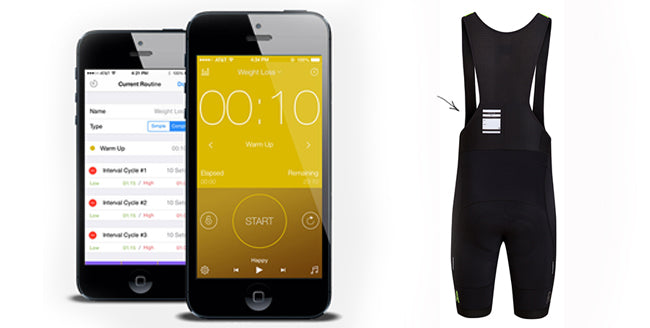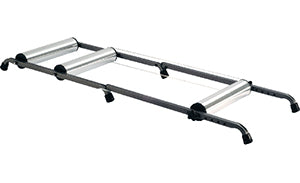
A turbo trainer is quite simply a device that enables you to ride your bike, stationary, indoors. As such they have become the go-to training equipment for the winter months and for warming up ahead of a race.
Many riders see turbo time as tortuous and/or extremely boring. Winter is often seen as turbo time, as icy conditions mixed with rain, wind and general unpredictability makes heading out on long rides no fun. Choosing to turbo is a safer and more time efficient riding option and allows you to safely work on top end speeds or sprints in a controlled environment.
Just like with most forms of exercise, turbo sessions require your hard work. Here are six ways to keep your winter willpower and get the most from the turbo:
Bib Shorts with Radio Pockets
Music is an ideal way to keep motivated and pass the time. Bib shorts with radio pockets built into the mesh straps mean you can tuck your iPhone away and run the ear phone cables along your back instead of having them dangle in front of you with the risk of catching the cable mid sprint and pulling the device onto the floor.
Get the session right
Planning your sessions on the turbo is vital. Having a specific idea of exactly what you will be doing will help you get the most out of your session, keep you motivated and allow you to taylor a session in order to improve on the previous one. We've noted some sessions below to get you started or try one of the free DVDs that are included with all CycleOps trainers.
Download Interval Apps
Ever miss an interval, do your scribbled notes seem incoherent mid ride? Designed for all sorts of training, not just cycling, Interval Timer (free) and Interval Timer Pro (£1.99) can be configured for you to keep track of your work and rest periods during sessions. The app allows you to tailor the sounds you hear, telling you to start or stop the interval, and you can save a number of different and varying workouts.

Stay comfortable
The A-frame of your turbo trainer unit will raise the rear of your bike by around four inches, pushing you into your gear/brake levers. Spending long amounts of time on the turbo in this position could become uncomfortable and you don't want to give yourself another reason to dismount. A riser block will help level the front wheel with the rear and keep the front wheel steady.
Keep a small towel close to hand to mop your face, arms and hands. If you have hard floor use a training mat, it will stop the unit marking your floor, and act as a sound barrier so you don't annoy the neighbours.

Get a pair of banging cans
You don't have to be Dr Dre to notice that a good pair of headphones create a much better sound and might be worthy investment on the long road to fitness, offering decent sound, a fit that stands up to the vibration and bumps and resistance to your ear-sweat. Over-ear headphones are preferred by our Rapha Condor JLT riders, "over-ear headphones feel more secure and aren't at risk of popping out of your ear, disrupting your session," explains Kristian House, try a pair of sweat resistant headphones like the Philips Action Fit or the Bose SIE2i.
Race the pros
Part of the excitement and enjoyment of cycling is the changing scenery and the wind on your face. Stuck inside looking at a blank wall churning away is seriously boring and your willingness to stay doing your turbo session will be tested. That's where 'The Sufferfest' comes in. The Sufferfest is a series of downloadable videos to pedal along to. Stick it on the laptop or burn it onto a CD and get on the turbo trainer. Follow the on-screen prompts and by the end of the hour's work-out you'll feel like you've been in a race.
Short on Time? 28 minutes is all you need
Tabata is a form of high intensity interval training. It involves short, brutal bursts of exercise, brief rest periods and lots of sweat. A study published by the European Journal of Applied Physiology found that you can significantly improve your aerobic fitness and VO2 max (cycling pace and endurance) in less time that it takes for an egg to boil and you to cut up your soldiers.
Research showed that seven 20-second all out sprints, three times a week, is enough to boost your aerobic capacity by 15%. The Colorado State university just found that participants in the their Tabata study scored better in cognitive tests too.
Warm up for 10 minutes
7 x 20 second all out 100% efforts with 10 second rest
4 minutes recovery
7 x 20 second all out 100% effort with 10 second rest
5 minute cool down
One of the most common mistakes is assuming more is better. Given the intense nature of interval training, you should do no more than three sessions per week.
Become a better sprinter
These are great to add on to the end of a session or as a full session as a race approaches. This session helps improve your 'jump' – helping you get your final sprint going or getting away in a break. The long recovery ensures the energy system used is fully recovered for the next full-on sprint effort, so choose a low gear and spin your legs.
One set:
10 x 15 seconds max sprint followed by 2 minute 45 seconds spin.
10 intervals per set with 5 minutes full recovery between sets.

Roller Rewards
Although essentially based on the same simple design that's been used for years, modern rollers have evolved and are much more user-friendly than those of old. There are a few benefits to rollers when compared with using a turbo trainer. The first is that riding on rollers is a fast-track method to improving your balance and bike handling skills. If you struggle on the road with basics such as holding a straight course when getting a bottle out of its cage, digging an energy bar out of your jersey pocket or putting on a waterproof on the go, then you could defnitely benefit from the balance and core stability training that rollers offer.
Riding on the rollers teaches you to improve the smoothness of your pedal stroke, which will ultimately make you a more efficient rider. An ideal session for developing cadence and smooth pedalling are 'Spin Ups'. You will need to fit a cadence sensor for this session.
5 minutes warm up - medium gear (39x18), ride easily, building your cadence to 100rpm.
Staying in the same gear, 'spin up' to the maximum cadence you can manage without bouncing.
Hold the cadence through to the end of the 30-second period. Concentrate on getting your lower legs and feet to relax.
Repeat the spin-up on every fifth minute (10, 15 and 20). Spin easily at 90-100rpm for each five-minute recovery.
Try these units and get free UK delivery
 |
 |
| CYCLEOPS MAG+ | CYCLEOPS FLUID 2 |
 |
 |
| CYCLEOPS ALUMINIUM ROLLERS | CYCLEOPS MAGNETO PRO WINTER TRAINING KIT |